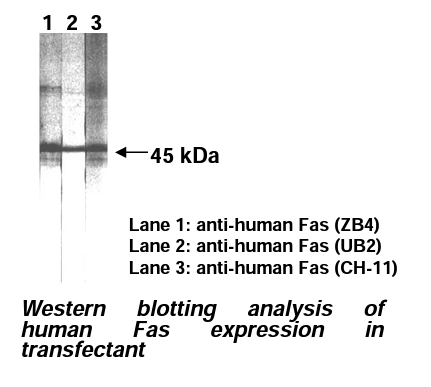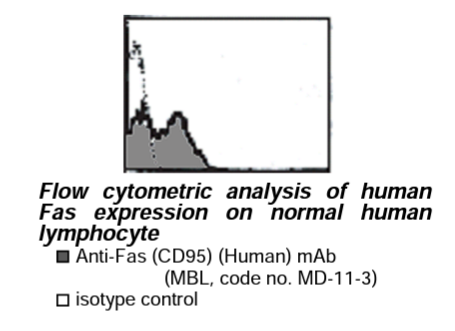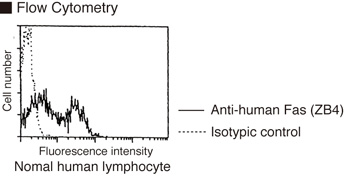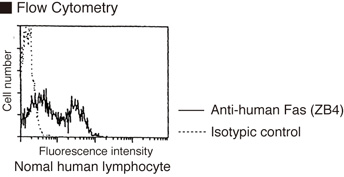Anti-Fas (CD95) (Human) mAb
| Code | Size | Price |
|---|
| MBL-MD-11-3 | 100 ug | £345.00 |
Quantity:
Prices exclude any Taxes / VAT
Overview
Host Type: Mouse
Antibody Isotype: IgG1
Antibody Clonality: Monoclonal
Antibody Clone: ZB4
Regulatory Status: RUO
Target Species: Human
Applications:
- Flow Cytometry
- Neutralisation
- Western Blot (WB)
Shipping:
4°C
Storage:
-20°C
Images
Documents
Further Information
Applications:
WB - 5 ug/mL (chemiluminescence detection system) FCM - 5-20 ug/mL (final concentration) NT - 10-500 ng/mL
Background:
It is now widely accepted that
apoptosis plays an important role in the selection of
immature thymocytes and Ag-primed peripheral T cells.
Fas (also known as CD95/APO-1) is a cell surface protein
belonging to the tumor necrosis factor receptor superfamily,
which is expressed in a variety of normal and neoplastic
cells. Binding of FasL to Fas or crosslinking of Fas by
anti-Fas monoclonal antibodies results in rapid induction of
apoptosis in Fas expressing cells. Clone ZB4 is known as
Fas blocking, Fas neutralizing or Fas antagonistic antibody,
whereas anti-Fas antibody (clone CH-11) is known as the
agonistic antibody.
Concentration:
1 mg/mL
Formulation:
100 ug IgG in 100 ul volume of PBS containing 1% BSA and 0.09% NaN3.
Gene IDs:
Human: 355 Mouse: 14102
Immunogen Translated:
Recombinant human Fas
Reactivity:
This antibody reacts with human Fas on
Western blotting and Flow cytomet ry. It does not react with
mouse Fas.
Shelf Life:
1 year
Source:
This antibody was purified from hybridoma
(clone ZB4) supernatant using protein A agarose. This
hybridoma was established by fusion of mouse myeloma
cell NS-1 with Balb/c mouse splenocyte immunized with
recombinant human Fas.
Target:
Fas
References
1) Arokium, H., et al., J. Virol. 83, 11283-11297 (2009)
2) Giammarioli, A. M., et al., Cancer Res. 68, 5291-5300 (2008)
3) Schumann, D. M., et al., PNAS 104, 2861-2866 (2007)
4) Maedler, K., et al., Diabetes 55, 2713-2722 (2006)
5) Gilhar, A., et al., Am. J. Pathol. 168, 170-175 (2006)
6) Ito, K., et al., Cancer Res. 65, 4417-4424 (2005)
7) Ahmed, F., et al., Blood 103, 2079-2087 (2004)
8) Holler, N., et al., Mol. Cell. Biol. 23, 1428- 1440 (2003)
9) Maedler, K., et al., PNAS 99, 8236-8241 (2002)
10) Maedler, K., et al., Diabetes 50, 1683-1690 (2001)
11) Jiang, S., et al., Invest. Ophthalmol. Vis. Sci. 41, 645-655 (2000)
12) Landowski, T. H., et al., Blood 94, 265-274 (1999)
13) Agrawal, S., et al., J. Clin. Invest. 102, 1715-1723 (1998)
14) Giordano, C. et al., Science 275, 960-963 (1997)
15) Boirivant, M., et al., J. Clin. Invest. 98, 2616-2622 (1996)
As clone ZB4 is really famous all over the world, a lot
of researches have been reported. These references are a
part of such reports.






